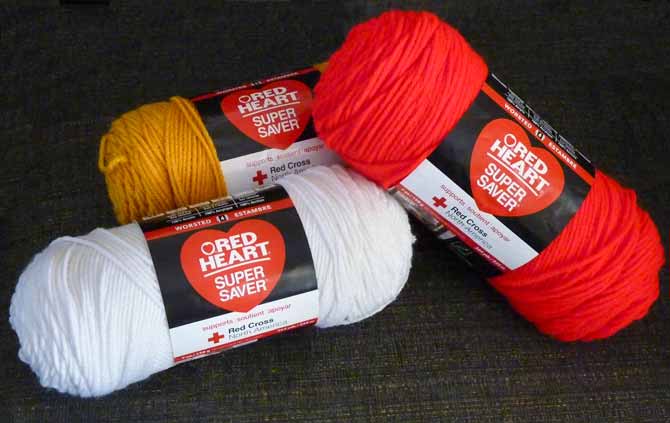Yesterday, we examined several design options for creating an afghan that incorporates a nation’s flag. Today, we’re going to look at choosing a yarn for our project.
When choosing yarn for a design, I like to consider its purpose as well as the recipient’s interest and ability to care for it. If I’m not sure, as is the case of this project, I will err on the side of wearability and ease of care. For my old Macedonian flag afghan, I chose Red Heart Super Saver.

Red Heart Super Saver yarn — affordable and durable.
Here’s why:
- It’s 100 percent acrylic, which means if it gets tossed into a washer or dryer, it’s going to survive.
- Chances are, this project will have a relatively short life, so I’m reluctant to choose a yarn that will require a large financial investment. Super Saver is affordable.
- Super Saver is an Aran weight yarn (18sts to 4″ [10cm], which means it will work up quite quickly, and if there’s one thing you want to see in an afghan project, it’s progress.
- Color range – Super Saver comes in over 120 colors. Many of these are variegated, and not suitable for re-creating a flag, however, the solid color range has an ample selection of the colors found in most national flags.
- Super Saver is put up in 7oz [198g] skeins each of which has 364yds [333m]. Theoretically, this means that there will be fewer ends to weave in compared with yarns that come in 50g balls.
Red Heart also makes two worsted weight yarns – Comfort and Classic Yarn. With a couple more stitches to 4″ [10cm] (20, versus 18 for Aran weight), Comfort and Classic Yarn allow for a slightly more detailed design.
If a faster knit is your goal, Red Heart has Comfort in a bulky weight (16sts to 4″ [10cm]), as well as an 80% acrylic, 20% wool line called Heads Up. Both yarns have enough colors to make many popular flags.
Take up the needles
The next piece of this design puzzle is to have a very good idea of what the tension of the afghan fabric will be.
Take the needles and yarn you plan to use, and make a reasonably large swatch – at least 6″ wide. The goal is to have enough fabric to accurately measure across a 4″ [10cm] span of the overall fabric (usually stockinette stitch for an afghan). To encourage the swatch to lay flat, I always add a few rows in either garter stitch or seed stitch at the beginning and end of the swatch, as well as a few stitches in the same stitch pattern on either side of the stockinette stitch area.
![Pins are placed 17 stitches apart, and the rule shows the distance of 4" [10cm] between the pins.](https://knitmuch.com/wp-content/uploads/redsample2reset-184524-f-sa.jpg)
Pins are placed 17 stitches apart, and the rule shows the distance of 4″ [10cm] between the pins.
An added advantage of framing your swatch is that you get to try a border treatment for your project. Seed stitch was used in the sample above.
Once you have a swatch, examine the fabric – Does it feel flexible enough to drape over chilly legs? Is it too loose to the point where it might stretch out of shape over time? If you aren’t sure you like the result, choose a different size needle, and try again. It may help to tag each sample you make with your thoughts and the needle size used. Leave room on the tag to record your tension. Some knitters like to keep their swatches for future reference — tagging them adds meaning to the swatches.
When you’ve settled on a sample that has the drape, or “hand” that you like, accurately measure the tension of the sample. It’s important to be very accurate when measuring. This step will make or break your project, especially if your design includes stars, circles, or leaves – anything where the height-to-width ratio has to be right. Our sample design features the vergina sun, so it’s important to take accurate counts for both stitches and rows.

The vergina sun is a beautiful shape, reminiscent of a mariner’s compass. Accurate tension measurements are essential to ensure that this design’s symmetry is retained when it is translated to a knitting chart.
When measuring stitches, I like to count from between “v”s, and when measuring rows, I like to count from the bottom point of the “v”s.
If your tension isn’t especially even, or if you get a questionable reading, move to another area of the swatch and measure again. Record your measurements accurately – if you get 19½ sts and 25¼ sts to 4” [10cm], these are the numbers to use. My sample has 17sts and 24½ rows to 4” [10cm].
Tomorrow we’ll determine the base numbers for our project using algebra and a spreadsheet (fun!), and design a simple striped flag.
